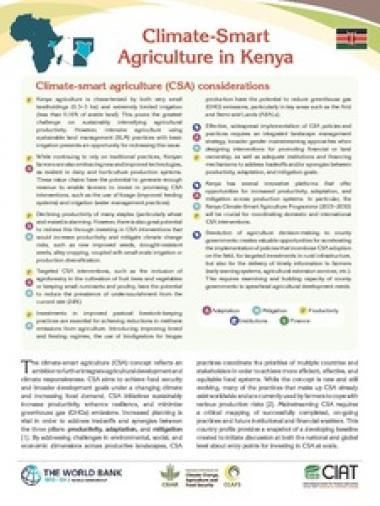Climate-Smart Agriculture in Kenya

The climate-smart agriculture (CSA) concept reflects an
ambition to further integrate agricultural development and
climate responsiveness. CSA aims to achieve food security
and broader development goals under a changing climate
and increasing food demand. CSA initiatives sustainably
increase productivity, enhance resilience, and minimize
greenhouse gas (GHGs) emissions. Increased planning is
vital in order to address tradeoffs and synergies between
the three pillars: productivity, adaptation, and mitigation
[1]. By addressing challenges in environmental, social, and
economic dimensions across productive landscapes, CSA
practices coordinate the priorities of multiple countries and
stakeholders in order to achieve more efficient, effective, and
equitable food systems. While the concept is new and still
evolving, many of the practices that make up CSA already
exist worldwide and are currently used by farmers to cope with
various production risks [2]. Mainstreaming CSA requires
a critical mapping of successfully completed, on-going
practices and future institutional and financial enablers. This
country profile provides a snapshot of a developing baseline
created to initiate discussion at both the national and global
level about entry points for investing in CSA at scale.
Citation
World Bank; CIAT. 2015. Climate-Smart Agriculture in Kenya. CSA Country Profiles for Africa, Asia, and Latin America and the Caribbean Series. Washington D.C.: The World Bank Group.